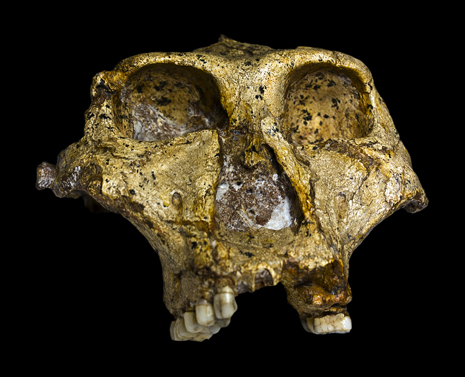Modern Research Methods Change Ideas on Early Hominin Diets

The researchers used cutting edge techniques to study the teeth of ancient hominins, including this species called Paranthropus Robustus, and found that the evolution of their diets probably differs from what scientists originally thought. Photo from Wikipedia Commons, José Braga/Didier Descouens.
FAYETTEVILLE, Ark. – Researchers employing the latest techniques to study the diets of early hominins are challenging long-held assumptions about what our ancestors ate.
Peter Ungar, Distinguished Professor of anthropology at the University of Arkansas, and Matt Sponheimer of the University of Colorado published their findings today in a review paper in the journal Science.
Ungar studies dental microwear, the pits and scratches that food leaves behind on teeth, which indicate whether our ancestors ate hard, brittle foods, such as seeds, nuts, roots or tubers, or tough foods, such as grasses and meat. Sponheimer studies stable isotopes of carbon in teeth, which tell researchers about the kinds of foods they ate. The scientists have used these techniques to study many of these early hominins, including specimens from the genera Paranthropus and Australopithecus. What they found does not fit with what scientists previously thought.
Until recently, scientists looked at the shape of a skull’s teeth and structure of the jawbone and skull to make hypotheses about what ancient hominins ate. Ungar and Sponheimer’s findings suggest that structure alone won’t work.
“The morphology tells you what a hominin could have eaten,” Ungar said. “But it doesn’t necessarily tell you what the animals did.”
The dental microwear and stable isotope studies show what kinds of foods our human ancestors actually ate.
“You’ve got fairly similar morphology within the genera, but we’re getting different diet signals between species,” Ungar said. In fact, their studies show that the dietary differences between species in eastern and South Africa were more significant than differences between the genera.
“You can’t dismiss both lines of evidence together,” Ungar said. “It suggests that maybe this same anatomy is being used for very different things.”
The scientists found that in particular, Paranthropus boisei stood out as an example of a creature whose form does not seem to match function. While the large jaws and broad teeth of boisei earned it the nickname “Nutcracker Man,” it appears that this particular species did not eat hard foods, but probably ate tough grasses or sedges much of the time, according to the two researchers’ studies.
“This combination of morphology and diet is not seen in any other primate,” Ungar said. He suggests that this behavior, the grinding of grasses with teeth that look like they should be used for cracking nuts, could be due to what he calls “phylogenetic baggage:” “Phylogenetic” is the evolutionary history, and the “baggage” is what your ancestors left you to work with. “It may be difficult for an animal that starts out with flat teeth to evolve sharp crests for shearing and slicing tough food,” he said. “We have to work with the anatomy we begin with.”
Further, while their techniques have prompted new findings in the field of biological anthropology, they are not limited to use in human ancestors. They could be used to determine more information about the prehistoric diets of any animals that leave behind teeth.
“This means that we are not limited to what the anatomy alone tells us,” Ungar said. Scientists used to think you could look at an animal’s skull and determine that it was a meat eater because of its sharp teeth. Ungar and Sponheimer propose that this is not necessarily the case. “We know that it could be a meat eater, but that perhaps now that can be checked. That’s now possible when we have independent lines of evidence to examine this.”
This research was in part sponsored by grants from the National Science Foundation.
Contacts
Peter Ungar, Distinguished Professor, anthropology
J. William Fulbright College of Arts and Sciences
479-575-6361,
pungar@uark.edu
Melissa Blouin, director of science and research communication
University Relations
479-575-3033,
blouin@uark.edu
Headlines
PetSmart CEO J.K. Symancyk to Speak at Walton College Commencement
J.K. Symancyk is an alumnus of the Sam M. Walton College of Business and serves on the Dean’s Executive Advisory Board.
Faulkner Center, Arkansas PBS Partner to Screen Documentary 'Gospel'
The Faulkner Performing Arts Center will host a screening of Gospel, a documentary exploring the origin of Black spirituality through sermon and song, in partnership with Arkansas PBS at 7:30 p.m. Thursday, May 2.
UAPD Officers Mills and Edwards Honored With New Roles
Veterans of the U of A Police Department, Matt Mills has been promoted to assistant chief, and Crandall Edwards has been promoted to administrative captain.
Community Design Center's Greenway Urbanism Project Wins LIV Hospitality Design Award
"Greenway Urbanism" is one of six urban strategies proposed under the Framework Plan for Cherokee Village, a project that received funding through an Our Town grant from the National Endowment for the Arts.
Spring Bike Drive Refurbishes Old Bikes for New Students
All donated bikes will be given to Pedal It Forward, a local nonprofit that will refurbish your bike and return it to the U of A campus to be gifted to a student in need. Hundreds of students have already benefited.




